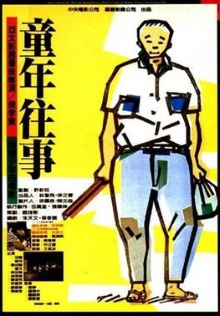
This is the second part of Hou Hsiao-hsien’s coming-of-age trilogy that began with A Summer at Grandpa’s. Considering what a great film that was, it would always be a hard act to follow and indeed this one is a much less impressive effort. It is not of course actually a sequel as it has an entirely different set of characters but it roughly covers the teenage years of its main male character and so can be thought of as a spiritual successor.
Ah-Hao is one of five children who grow up in a small town in Taiwan. The father moved from mainland China to take up a post and originally only intended to stay for a few years but is now unable to return due to the conflict between the Nationalists and the Communists. Ah-Hao is the favorite of the grandmother who lives with them as fortune teller told her that he would become a high level official. However he grows up as a rebellious brat who constantly gets in trouble. Though the family is never well off, things only get worse when the father, who has always had sickly lungs, dies. The eldest daughter is married off and the eldest brother becomes a teacher. Ah-Hao himself however falls in with the local street gang and gets into fights.
The earlier film had the benefit of a tight focus on a single character and being limited to the span of a single summer holiday. As the events of this film takes place over many years with a significant time skip partway through, the focus here is more diffuse and indeed it’s more about the family as a whole rather than just Ah-Hao himself. This alone makes it a less effective film. Then add the fact that Ah-Hao is a rather unsympathetic character and as most of us have already seen similar stories about these naughty boys, and it becomes even less interesting. In fact, some of my favorite bits about this film usually don’t involve Ah-Hao at all such as the mother reminiscing about the early years of their marriage to the daughter or how one of his young brother has a habit of drinking milk and is extremely diligent about practicing calligraphy. It’s easy to see that the character of Ah-Hao is based on the director’s own childhood but his story just isn’t that compelling.
Also fascinating are the scenes which reveal how the characters see China. News on radio and a squad of armored vehicles passing in the night, leaving marks of their threads on the ground, tell us that military conflict was very much ongoing at the time. At school, one boy excitedly tells everyone that he has heard that they are on the verge of recapturing the mainland, only to be soundly ridiculed by his classmates. Best of all is Ah-Hao’s addling grandmother who keeps wishing to return to China and seems to believe that she can get there overland. One day she takes Ah-Hao on an adventure to their home village so that he can pray to their ancestors and naturally they get lost. She is continually wandering out herself and being sent home by rickshaw drivers. All this is far better material than the rather generic story of Ah-Hao’s coming of age.
One thing my wife noticed is that the cinematography is better when it comes to wide, expansive shots and visibly weaker in close-in shots with just one or two characters. Hou Hsiao-hsien is very strong when he is able to show his characters as part of their setting but there’s something that feels dull when his characters have to carry the scene by themselves. It’s very different from someone like Tsai Ming-liang where an actor’s face alone can tell a story. Overall I found this to be a solidly decent film but it’s nowhere as good as the previous one. I think it could have been improved if the director’s sad memories of his childhood could have been balanced out by happier memories. As it is, this feels too similar to the standard tearjerkers of the era.